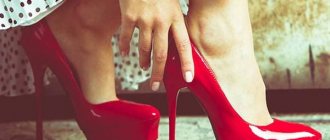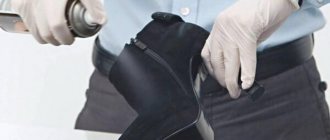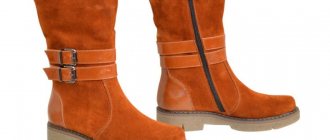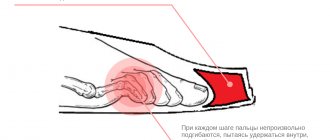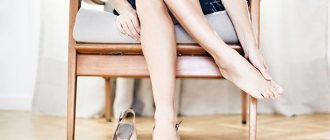Many owners of new shoes are faced with a common problem such as blisters. The joy of the happy owners of just purchased sandals or sneakers, shoes, boots immediately disappears.
We will share tips, recommendations, and interesting life hacks on the topic: what to do to prevent your favorite shoes from chafing in this article with a video. Of course, you can patiently break in your shoes, change the adhesive plaster every hour, and clench your teeth with every step. But leg health is hardly worth such sacrifices.
To avoid discomfort and not give up elements of a stylish look, you need to know what to do if your shoes rub, what secrets you need to use to make shoes, sandals or sneakers fit.
Why do shoes rub, and which ones are most common?
First of all, it is necessary to identify the cause-and-effect relationship why an important and integral element of your image began to cause inconvenience. There may be several options:
- Incorrect size. If the shoes fit too tightly and are too tight, they almost always irritate the skin, and this leads to wounds and calluses.
- Hard backs or dense and rough material of shoes. As a rule, these are new shoes, ballet flats or winter boots. In such models, the back of the shoe often rubs; what to do and how to soften the fabric, read below.
- Inappropriate model. Each person's feet are unique, which is why not only the correct size must be selected, but also the correct model. The numbers on the soles do not always guarantee that the shoes will fit you.
- Most often, shoes made of rough leather or its artificial substitutes rub. Also occupying a leading position are tight sandals, ballet flats, and winter boots, most of them for women, tailored to fit the foot.
- Swelling is another reason. Due to sedentary work or body characteristics, diseases, the legs may swell, especially in the ankles and toes. This is what causes calluses to form.
Advice: If foot chafing occurs due to health problems, it is better to consult a doctor for advice. Swelling is a serious sign of problems in the body, in particular diseases of the cardiovascular system.
Rubs the edge of the shoes
If the edge of your shoes rubs
Sometimes it happens that everything is fine in the shoes, but one edge of it literally digs into the skin.
This usually happens at the junction of two or more parts. If you don't know what to do with such a pair, try purchasing the same silicone self-adhesive pads as special tapes for sandals. They have the shape of a small circle or oval and are attached from the inside to the place where there is a defect. Usually this is enough to make wearing shoes easier and more comfortable. To the list of news
What to do to prevent shoes from rubbing
To the question: what to do if your shoes are tight, sneakers or boots fit too tightly and thereby contribute to the appearance of calluses, you can answer by offering several effective options. It is recommended to break in the wardrobe item gradually at home. Start with 5 to 7 minutes a day.
Soap or candle. A popular effective method that everyone can afford. Take a piece of unwanted soap or a candle and rub it on the area that is chafing you. Typically this is the heel. Continue until the fabric or leather is soft and stretched.
Plastic bag + frozen. If you don't know how to break in patent leather shoes, try this option. Fill plastic bags with water and place them in boats. Place the shoes in the freezer for 2-3 hours, then remove them. Try it on after 30 minutes. The method should help.
Wool socks. You can also try wearing a thick thick sock (preferably wet) and shoes over it. Direct the hair dryer to the area that is pinching. Continue the procedure for 15-20 minutes.
Important: this method is not suitable for all types of shoes. Be careful, wardrobe items made of genuine leather will not survive this procedure.
Stretching foam. A convenient and practical spray can be used for newly purchased new clothes.
The stretcher is a chemical agent and may affect the color of the product. Try spraying the foam on a small area of your sneaker, shoe or boot. If there is no reaction, then you can use the product.
Apply foam to the inside of the shoe, then put it on and wear it for an hour. You should not use this method for leatherette. It can crawl apart before our eyes.
Special spray. A quick way to restore comfort and convenience to your feet. As a rule, the product is in a spray bottle. You just need to apply it on top of the shoes and inside. Next you need to proceed in the same way as with stretch foam. To enhance the result, wear a thicker sock.
Newspaper. When you don't know what to do if your new shoes are rubbing, try using the grandfather method. Wet the newspapers, crumple them and tamp them into each boot or shoe. Leave the shoes in this form until the paper is completely dry. Instead of newspaper, you can use damp towels, clean rags or napkins.
Important: do not dry shoes, especially leather ones, on the radiator. High temperatures are harmful, they can deform the material and ruin the color.
Ethanol. A very aggressive way to soften shoes, which is not suitable for all types of boots. Therefore, you need to be extremely careful with its use. Soak a cotton pad thoroughly in an alcohol solution and rub the shoes front and back. Then wear the new thing for about an hour. It is recommended to try the product on a small area first. You can also soak thick socks in alcohol, put them on and then walk around the house like that for 10-15 minutes. Repeat this procedure 3-4 times a day.
Castor oil. Suitable for almost all materials except textiles.
A soft and inexpensive way to soften fabric, which can even handle patent leather shoes, as well as artificial leather and suede. By the way, instead of oil, you can use pharmaceutical Vaseline. Process the product from the side, as well as from the front and back. Let it wear for 1-2 hours. Then wash the surface with soap. Cold. A method that is not recommended for expensive shoes will help you avoid chafing. Observe the following condition: do not do this with leather or leatherette. Water can be poured into bags or filled with ice cubes in shoes and left until completely thawed. Then put it on and wear it.
Cloth and hammer. A necessary and indispensable method if you need to soften the hard backs of a new thing.
This option is especially good for suede, leather, fabric for sports shoes, and also if the back of ballet shoes are rubbed, the method described below will tell you what to do in this situation. Take a hammer and a piece of thick fabric. Cover the problem area with the cloth, under which it is advisable to place a piece of wood. Tap with a hammer, covering the entire area. Then try on sandals or shoes. Repeat the procedure if necessary.
Glycerol. One of the effective ways to treat shoes, including the shaft, and then stretch them. To soften the material in the area of the little fingers, you need to regularly rub the sealed areas with glycerin. Proceed according to the following instructions:
- Soak a clean terry towel in warm water.
- Wrap your shoes in it and leave for 30 minutes.
- Next, lubricate your shoes with pharmaceutical glycerin and try walking for an hour.
Baby cream or fat. This option is useful for leather or its substitute. The material tends to get rough over time, so it often rubs in the area of the bones on the fingers. To correct the situation, you can apply baby cream or fat to the hard spots overnight. Afterwards, the shoes must be washed. For best results, it is recommended to do the procedure several times.
Heel guards. This is a special shoe lining that will stop your favorite shoes from rubbing. They have a powerful effect when used correctly, so familiarize yourself with how to put them on. Silicone heel straps need to be secured from the inside of the shoe, adjusting the size. You should not press the strips too hard, because you may not guess where they are located, then you will have to re-glue them, and the gel strips will no longer have the same tenacity. The heel guard is very easy to use and is transparent which is an added bonus.
Advice: if none of the listed remedies helped or gave poor results, seek help from specialists at a shoe store.
Special means
Stretching tight shoes using improvised means is cheap and convenient. However, with this approach there is always a risk of ruining expensive shoes. Today, to solve the problem, special sprays and stretching foams have been developed, which are simple and safe to use.
Sprays
Basically, the rules for working with sprays from different manufacturers are the same: the composition is sprayed inside and outside the shoe, the shoes are put on the foot (preferably on a nylon or cotton sock) and worn in for half an hour. You shouldn’t expect the product to increase much in length, but the sides and nose will become much softer, and you won’t have to rub your feet with shoes again. The effect of using industrial stretch marks becomes noticeable after several treatments.
Here are a few products that have received positive customer reviews:
- Salamander Shoe Stretch - for genuine leather and suede;
- Pregrada - for all skin types;
- Damavik - for artificial and natural leather, suede;
- TWIST - for leather, suede, velor, nubuck;
- SALTON - for smooth leather, suede, patent leather, nubuck.
We recommend: How to teach noisy upstairs neighbors a lesson: “bad advice” and legal methods
Protective strips
In shoe stores, along with a new pair, you can purchase protective strips and heel guards, which are glued inside the shoes for comfortable wearing. To accurately determine the location of the possible appearance of a callus, you need to remember your experience with previous shoes or sandals. Where they rubbed the most, a protective strip is glued there.
Anti-slip insoles
Insoles with anti-slip coating will help you adapt to shoes that are slightly larger than desired. Especially if the model is wearing high heels. Those whose feet sweat profusely cannot do without this device. The insoles absorb excess liquid, the foot remains dry and does not slip inside the sandal. On sale you can also find special lasts for stretching new shoes to the desired size.
You can buy a pencil against calluses at the pharmacy. It contains nourishing, emollient, and sometimes antiseptic components. Before going out in new shoes, the feet in those places where abrasions may appear are lubricated in advance with a pencil and save yourself from troubles for the whole day. Medifit and Compeed pencils have proven themselves to be the best.
What to do with calluses
A callus is formed from excessive rubbing of the skin and is a bubble filled with liquid, which then bursts. An infection can easily penetrate an open wound, which can lead to suppuration and is very dangerous to health, so you should not take calluses lightly.
If the bubble in front of your toes or on the heel has burst, treat the area with peroxide, and then apply brilliant green around the wound. You can also use alcohol. There is no need to pour it onto the damaged area; do it with a cotton pad or ear swab. If the bubble is still full, press it with a clean bandage, and then carry out the disinfection procedure. An open wound can be sealed with a bactericidal adhesive plaster.
Beauty requires sacrifice?
Which shoes should you choose – comfortable or beautiful? High-heeled shoes or sandals will certainly add a sexy touch to your look, but the comfort of such a pair is out of the question. Therefore, if you have to be on your feet all day, rushing around the city on public transport, it is much more practical to wear ballet flats or moccasins. In worn-in, low-speed shoes, you will feel more confident when catching up with a bus or trying to squeeze into a crowded subway car.
It's another matter if elegant shoes are a mandatory element of the office dress code. Before you take your new pair out to work, you should walk around in them at home, but don’t try to act like a “model walk.” If you feel discomfort in the heel or toe area, then before going out, you should adapt the pair as much as possible, otherwise, you risk developing calluses even in that short period of time while you flaunt your new look from the door of your own apartment to a car parked in the yard .
Blisters, calluses, chafing are seasonal problems for women’s feet.
Why do chafing and blisters on the back of the heels and in the toes appear more often in the warm season? Firstly, in the summer the likelihood of swelling increases, which is why at the end of the day it can be difficult to take off shoes that were just in time. The material of the shoes rubs against the already swollen skin, which leads to the formation of so-called “dropsy”.
Secondly, in the hot season we sweat intensely. Sweat mixes with particles of dust, sand and other similar delights and becomes a kind of abrasive, “sealed” between the inner surface of the shoe and the skin. Naturally, the lucky ones manage to get by without calluses in such a situation.
Thirdly, the size and fullness of the new shoes are chosen incorrectly, and the shoes either squeeze the foot like a vice, or, on the contrary, mercilessly fidget and rub the delicate skin of the feet. In this case, you can try to wear your shoes in or insert special insoles to prevent the foot from “lobbing” or excessive sliding.
How to choose the right shoes
Questions about what to do to prevent shoes from rubbing and why they feel too tight are always nearby. The discomfort experienced by the foot and lower leg can lead to health problems, so you need to take the choice of good, high-quality, and most importantly, comfortable shoes seriously and carefully. Here are some tips on how to do it correctly:
- Choose boots, sneakers, sneakers or shoes half a size larger.
- Be sure to try on two shoes before purchasing.
- Jump or run in place in your new clothes. Try turning your foot in different directions. Check your shoes for comfort.
- Look carefully at the condition of the seams and other parts of the boot.
- Do not buy shoes that are too tight and hard. Give preference to soft and comfortable sandals and sandals.
- Go shopping for new things in the evening. Your feet may swell, which is why you shouldn’t go to the store in the morning, because then you might not be able to fit into your sneakers.
- Try on a new sock, preferably a thick one or a winter one. The exception is summer shoes.
As you can see, there are many tips and recommendations on how to cope with regular rubbing of calluses. Try different options and wear your shoes with pleasure. Let it be not only beautiful and stylish, but also very comfortable and practical. Our tips for different fabrics and materials will help you in this matter.
Did you like the article? Save it to your Pinterest! Hover over the image and click “Save.”
How to deal with it
Ways to help deal with chafing
Shoes may be new or old, true to your size, but from time to time your feet will rub in different places. This can be caused by many reasons - swelling on a hot day or during heavy physical activity, increased sweating, dust, sand getting into shoes, structural features of the foot, inconsistency of the chosen pair and many other factors.
There are several options for action that you can take if your shoes are rubbing. All of them are designed to either reduce friction or eliminate its cause.
How to break in suede shoes
Shoes made of delicate material stretch well using any of the methods used for leather. In addition, you can use the traditional method using potato peelings.
- Stuff your shoes tightly with potato peelings.
- Leave for 12 hours.
- Remove the contents.
In this case, the softening effect is provided by starch, which is released from the peelings.
Elimination of swelling as a prevention of chafing of the feet
Each person's body reacts differently to heat and physical activity. And increased swelling of the legs does not always indicate serious illness. But it can easily become the cause of blisters and chafing!
If you have a tendency to edema, try to avoid high-heeled shoes, tight, not yet properly worn-in sneakers, and sandals on particularly hot days. Uncomfortable shoes will only aggravate the swelling, and will most likely irritate the skin into watery calluses.
At work, you should always have shoes with low heels or wedges, with uppers made of natural materials. They will be a real salvation for your feet after elegant stiletto heels or sandals with hard buckles. Daily massage of the feet and legs using special gels will make blood vessels and capillaries work more actively, reducing swelling and, accordingly, the risk of chafing.
How to cure a callus
When calluses have already appeared, what to do ? Take a cool bath with chamomile or calendula infusion. If the water callus has burst, treat it with hydrogen peroxide. When putting on your shoes, cover them with antibacterial tape.
At night, apply a cut aloe leaf or lemon peel with white pulp to the callus. By spring, stock up on ointments - Levomekol, streptocidal ointment or Solcoseryl.
To successfully choose a new item, make your purchase in the late afternoon, when your feet are a little swollen. If the product fits well on your foot in the evening, then it will be more comfortable to wear.
Stick against calluses Step Up
Another stick that reduces friction and allows you to forget about calluses even in new shoes. The main thing is to remember to put it in your purse in case you plan to wear sandals all day: the coating may need to be renewed. The Step Up stick is available for women and men, the only difference is the fragrance. The one for girls smells nice of bubblegum!
Price: about 50 rubles.
Sprays for stretching shoes
Just a couple of hours ago in a shoe store you admired the beauty of the brand new shoes you just purchased, but now you realize that they are a little small for you? If you really like the chosen pair, you can try to solve the problem with the help of a special foam, a spray for stretching shoes.
The purchase of such a product becomes especially relevant if you need to break in expensive shoes, and you are afraid of hopelessly ruining a pair by applying one of the many tips from the people. Special cosmetics for shoe care can soften and stretch natural leather to a certain extent without damaging the appearance of the product.
Scholl Velvet Foot Moisturizing Serum
What to do to prevent shoes from chafing? Moisturizing serums with hyaluronic acid are available not only for the face, but also for the legs! If you want your shoes to rub less and rough skin to become softer, use the serum daily - it helps maintain moisture balance and makes your feet soft. And with the help of this serum you can maintain the effect longer after a pedicure.
Price: about 800 rub.
How to wear patent leather
The peculiarity of the material is the application of a special coating. In order not to violate its integrity, you need to use gentle compounds.
Alcohol-water solution
This composition will help to distribute tight shoes in certain places, preserving the structure of the varnish coating.
- Mix 2 parts alcohol with 1 part water.
- Soak your socks in the solution.
- Put socks on your feet.
- Walk in them until they dry out.
The softening component has a delicate effect on varnish models.
Fat cream
You can use any nutritional composition for the body.
- Treat problem areas with cream. Apply the substance liberally.
- Use pads or put the model on your feet with thick socks.
- Leave for 2 hours. If necessary, extend exposure time.
This is a safe way to widen tight shoes that feel tight in the toes or sides.
Advice! Patent leather shoes should not be subjected to freezing, hot or chemical treatment. This will ruin the material.


